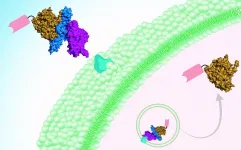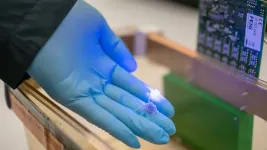(Press-News.org) While rare, botulism can cause paralysis and is potentially fatal. It is caused by nerve-damaging toxins produced by Clostridium botulinum -- the most potent toxins known. These toxins are often found in contaminated food (home canning being a major culprit). Infants can also develop botulism from ingesting C. botulinum spores in honey, soil, or dust; the bacterium then colonizes their intestines and produces the toxin.
Once paralysis develops, there is no way to reverse it, other than waiting for the toxins to wear off. People with serious cases of botulism may need to be maintained on ventilators for weeks or months. But a new treatment approach and delivery vehicle, described today (?) in Science Translational Medicine, could change that.
"There are anti-toxins, but these only work before the toxins enter the motor neurons," says Min Dong, PhD, a researcher in Boston Children's Hospital's Department of Urology and corresponding author on the paper. "What we have developed is the first therapy that can eliminate toxins after they get inside neurons."
If proven in humans, the approach would represent a breakthrough in treating botulism. In mice, the treatment successfully got inside neurons, reversed muscle paralysis within hours, and enabled mice to withstand doses of botulinum toxin that would otherwise be lethal.
Letting a toxin lead the way
Dong and his colleagues needed to surmount two technical barriers that have prevented the botulism from being treated effectively in the past. Intriguingly, their solution lay in botulinum toxin itself.
"One barrier to treatment has been getting across the cell membrane, which is difficult for protein drugs," explains Shin-Ichiro Miyashita, PhD, a postdoctoral fellow in Dong's lab and first author on the paper. "The other is targeting specific cell types, and in this case specificity toward motor neurons and nerve terminals. We took advantage of the fact that botulinum neurotoxins target motor neurons naturally and efficiently, and can deliver a protein cargo across cell membranes."
The treatment is therefore two-pronged. A botulinum toxin (detoxified through introduced mutations) is the delivery vehicle. The cargo -- i.e., the active drug -- is a mini-antibody derived from the antibodies of camels, developed by collaborator Charles Shoemaker, PhD, at Tufts University. The team showed that two of these so-called nanobodies can be delivered in tandem into neurons, neutralizing botulinum toxins type A and B at one go.
But there was one more problem to solve.
"This idea and approach had been attempted, but it was difficult to completely get rid of toxicity," says Dong, "until we identified a new toxin, botulinum neurotoxin X, in 2017. Unlike other botulinum toxins, this new toxin shows no toxicity after we introduce mutations, and serves as a safe delivery tool."
Botox reversal
Besides botulism, Dong thinks the new treatment could be useful as a "botox reversal" agent. Botox injections, using tiny quantities of the type A botulinum toxin, can safely treat wrinkles and many other medical conditions like neck spasms, excessive sweating, or overactive bladder. However, when the injection goes awry, botox can cause unwanted muscle paralysis as a side effect, and patients have to live with the paralysis for months.
"We can potentially inject our therapeutic protein and get rid of botox in neurons and paralysis within a few hours," Dong says.
A general delivery platform for neuroactive drugs?
The toxin-guided approach may offer a platform for getting biologic drugs into neurons to treat other disorders, Dong believes. Currently, most biologic drugs act only on cell-surface targets and cannot get into the cell's interior.
"We provide a protein-based drug delivery platform that achieves highly specific targeting of neurons and efficient penetration of cell membranes," Dong says. "Combined with nanobodies, which can be developed fairly readily against any protein of interest, this platform can be used to develop therapeutics that modulate proteins and biological processes inside neurons. Its modular nature even allows us to target cell types other than neurons by switching the cell-targeting domain. This could present a general approach for precision drug delivery into cells."
INFORMATION:
Jie Zhang and Sicai Zhang of Boston Children's Hospital and Charles Shoemaker of Tufts University are co-authors. The research was supported by the National Institutes of Health and Intelligence Advanced Research Projects Activity (IARPA).
More than half of people who use medical marijuana products to ease pain also experience clusters of multiple withdrawal symptoms when they're between uses, a new study finds.
And about 10% of the patients taking part in the study experienced worsening changes to their sleep, mood, mental state, energy and appetite over the next two years as they continued to use cannabis.
Many of them may not recognize that these symptoms come not from their underlying condition, but from their brain and body's reaction to the absence of substances in the cannabis products they're smoking, vaping, eating or applying to their skin, says the University of Michigan Addiction Center psychologist who led the study.
When someone ...
Gastric bypass surgery is sometimes the last resort for those who struggle with obesity or have serious health-related issues due to their weight. Since this procedure involves making a small stomach pouch and rerouting the digestive tract, it is very invasive and prolongs the recovery period for patients. In a new study, researchers at Texas A&M University have described a medical device that might help with weight loss and requires a simpler operative procedure for implantation.
Researchers said their centimeter-sized device provides the feeling of fullness by stimulating the endings of the vagus nerve with light. Unlike other devices that require a power cord, their device is wireless and can be controlled ...
TAMPA, Fla. (Jan. 8, 2021)- New research led by the University of South Florida has uncovered one of the reasons jellyfish have come to be known as the "world's most efficient swimmer." Brad Gemmell, associate professor of integrative biology, found jellyfish produce two vortex rings, which are donut-shaped bodies of fluid underneath their translucent bodies, that spin in opposite directions. They appear as jellyfish squeeze and reopen throughout each swim cycle, providing a "ground effect" force as if they were to be pushing off the seafloor.
The "ground effect" is most widely understood ...
Scientists from Russia, Austria, and the USA have discovered virus-like particles in the bacterial symbionts of Bryozoa - a phylum of colonial aquatic invertebrates - filter-feeders dominating in many bottom ecosystems. The research project was planned and supervised by scientists from St Petersburg University. Some of the virus-like particles resemble red blood cells, while others have a sea-urchin-like appearance. Although viruses have never been reported inside symbiotic bacteria in bryozoans, scientists suggest that this "matryoshka doll" may have a prominent effect on the bacterial ...
What The Study Did: This study adapted a well-established tool for measuring inequity from economics--the Lorenz curve--to measure racial inequities in COVID-19 testing.
Author: Aaloke Mody, M.D., of the Washington University School of Medicine in St Louis, is the corresponding author.
To access the embargoed study: Visit our For The Media website at this link https://media.jamanetwork.com/
(doi:10.1001/jamanetworkopen.2020.32696)
Editor's Note: The article includes funding/support disclosures. Please see the article for additional information, including other authors, author contributions and affiliations, conflict of interest and financial disclosures, and funding and support.
INFORMATION:
Media ...
CHAMPAIGN, Ill. -- Religious people facing life crises rely on emotion-regulation strategies that psychologists also use, a new study finds. They look for positive ways of thinking about hardship, a practice known to psychologists as "cognitive reappraisal." They also tend to have confidence in their ability to cope with difficulty, a trait called "coping self-efficacy." Both have been shown to reduce symptoms of anxiety and depression.
The new findings are reported in the Journal of Religion and Health.
"It appears that religious people are making use of some of the same tools that psychologists have systematically identified as effective in ...
Announcing a new publication for BIO Integration journal. In this opinion article the authors Daiyun Xu, Yonghui Lü, Yongxiao Li, Shengbin Li, Zhe Wang and Junqing Wang from Sun Yat-Sen University, Guangzhou, China discuss ferroptosis resistance in cancer.
Ferroptosis is a lethal consequence of accumulated lipid peroxidation catalyzed by ferrous iron and oxygen. This unique cell death process appears to involve many diseases, such as neurodegeneration, ischemia/ reperfusion injury, kidney disease, and a druggable target in therapy-resistant cancers. Ferroptosis may provide hope for ...
Humans depend on their senses to perceive the world, themselves and each other. Despite senses being the only window to the outside world, people do rarely question how faithfully they represent the external physical reality. During the last 20 years, neuroscience research has revealed that the cerebral cortex constantly generates predictions on what will happen next, and that neurons in charge of sensory processing only encode the difference between our predictions and the actual reality.
A team of neuroscientists of TU Dresden headed by Prof Dr Katharina von Kriegstein presents new findings that show that not only the cerebral cortex, but ...
In a study published in Physical Review Letters, the team led by academician GUO Guangcan from University of Science and Technology of China (USTC) of the Chinese Academy of Sciences (CAS) made progress in high dimensional quantum teleportation. The researchers demonstrated the teleportation of high-dimensional states in a three-dimensional six-photon system.
To transmit unknown quantum states from one location to another, quantum teleportation is one of the key technologies to realize the long-distance transmission.
Compared with two-dimensional ...
In a study published in Advanced Materials, the researchers from Hefei National Laboratory for Physical Sciences at the Microscale, the University of Science and Technology of China of the Chinese Academy of Sciences, using an electron-proton co-doping strategy, invented a new metal-like semiconductor material with excellent plasmonic resonance performance. This material achieves a metal-like ultrahigh free-carrier concentration that leads to strong and tunable plasmonic field.
Plasmonic materials are widely used in the fields including microscopy, sensing, optical computing and photovoltaics. Most common plasmonic materials are gold and silver. Some other materials ...





